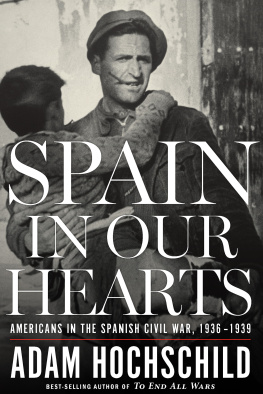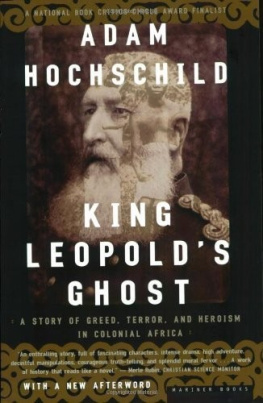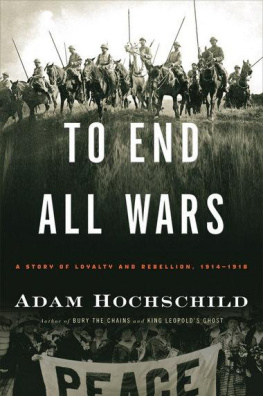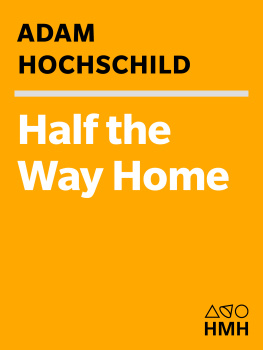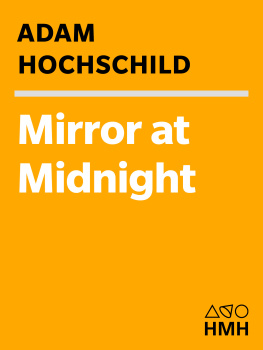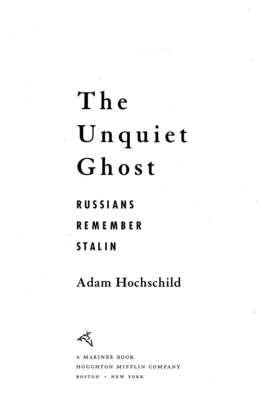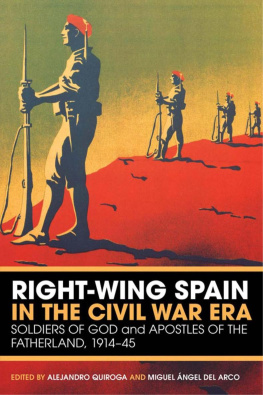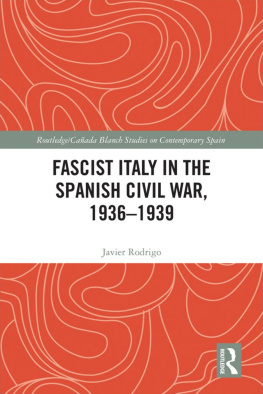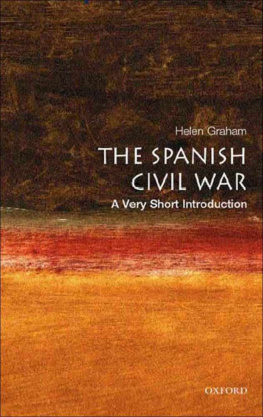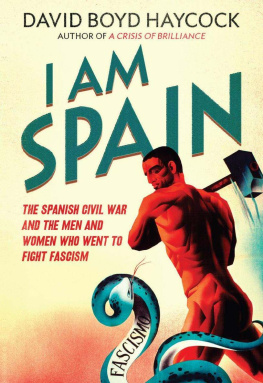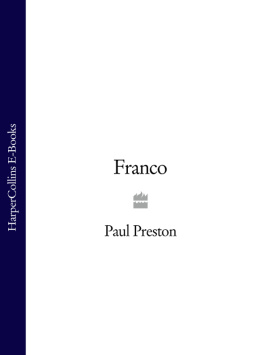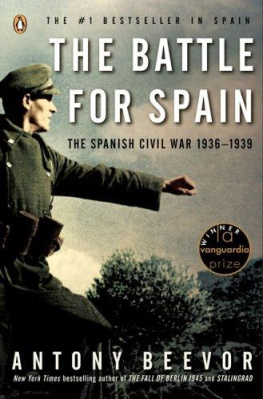Copyright 2016 by Adam Hochschild
All rights reserved
For information about permission to reproduce selections from this book, write to or to Permissions, Houghton Mifflin Harcourt Publishing Company, 3 Park Avenue, 19th Floor, New York, New York 10016.
www.hmhco.com
Library of Congress Cataloging-in-Publication Data is available.
ISBN 978-0-547-97318-0 (hardback) ISBN 978-0-547-97453-8 (ebook)
Portions of this book have appeared, in different form, in the New York Review of Books, the American Scholar, the Volunteer, and California.
The author is grateful for permission to quote from the following: The Complete Works of George Orwell, edited by Peter Davison, copyright the Estate of the late Sonia Brownell Orwell, reproduced by permission of The Random House Group Ltd. and A. M. Heath & Company Ltd. Crusade in Spain by Jason Gurney, copyright 1974 by Mrs. Judith Gurney, all rights reserved, reprinted by permission of Faber and Faber Limited. Looking for Trouble by Virgnia Cowles, reprinted by permission of Harriet Crawley. War Is Beautiful, by James Neugass, courtesy of the American Lincoln Brigade Archives (ALBA).
Cover design by Michaela Sullivan
Cover image: Civilian casualty, Teruel front, December 1937
Photograph by Robert Capa International Center of Photography
v1.0316
For Rosa and Sonia
Maps
Authors Note
Where place names have a common rendering in English, I have used them, such as Majorca, Navarre, Seville, Aragon, Cordova, Catalonia, and Saragossa. Where todays maps show Basque or Catalan town or street names, I have nonetheless used the Spanish version when that is how the name appears in writings from the civil war era; hence Guernica, Marsa, the Ramblas, and so on. Some errors in Spanish words or phrases quoted by American journalists and volunteers have been silently corrected, but I have not altered the occasionally erratic English spelling and punctuation of their letters and diaries.
Prologue: Far from Home
D AYBREAK, APRIL 4, 1938. Shivering, exhausted, and naked, two bedraggled swimmers climb out of the freezing water and onto the bank of Spains Ebro River, which is swollen with melted snow from the Pyrenees. Both men are Americans.
The country is in flames. For nearly two years, the fractious but democratically elected government of the Spanish Republic has been defending itself against a military uprising led by Francisco Franco and backed by Nazi Germany and Fascist Italy. Franco, who has given himself the title of Generalissimo, has a framed photograph of Adolf Hitler on his desk and has spoken of Germany as a model which we will always keep before us. The skies above the Ebro this dawn are dark with warplanes, state-of-the-art fighters and bombers, flown by German pilots, that the Fhrer has sent the Generalissimo. On the ground, tanks and soldiers from Italy, some of the nearly 80,000 troops the dictator Benito Mussolini will loan Franco, have helped launch the greatest offensive of the war. A powerful drive from the western two thirds of the country, which Franco controls, its goal is to reach the Mediterranean, splitting the remaining territory of the Spanish Republic in two.
Francos prolonged battle for power is the fiercest conflict in Europe since the First World War, marked by a vindictive savagery not seen even then. His forces have bombed cities into rubble, tortured political opponents, murdered people for belonging to labor unions, machine-gunned hospital wards full of wounded, branded Republican women on their breasts with the emblem of his movement, and carried out death sentences with the garrote, a medieval iron collar used to strangle its victim.
Battered by the new offensive, the Republics soldiers are retreating chaotically, streaming eastward before Francos troops, tanks, and bombers. In some places, his rapidly advancing units have leapfrogged ahead. The Republican forces include thousands of volunteers from other countries, many of them Americans. Some have already been killed. Franco has just announced that any foreign volunteers taken prisoner will be shot.
Cutting through rugged mountainous country in Spains northeast, the fast-flowing Ebro, the countrys largest river, marks the line between death and safety: the east bank is still in Republican hands. Small clusters of American volunteers, trapped behind the lines, have succeeded in slipping past Francos troops by night, navigating by the North Star. After three days with little sleep, pursued by soldiers, tanks, and cavalry guided by spotter planes circling overhead, they reach the Ebro before dawn, near a point where a bridge appears on the map. The bridge, they discover, has been blown up, and there are no boats. A few of those who cannot swim desperately tear a door from an abandoned farmhouse to use as a raft; other nonswimmers enter the river clinging to a log. Swept away by the current, at least sixfour of whom are woundedwill drown.
Three remaining Americans who can swim strip off their boots and all their clothing and plunge into the icy water. One of them lands far downstream, but two young New Yorkers, John Gates and George Watt, who has a sprained ankle and a shrapnel wound in his hand, wade out of the water together on the far side. As morning breaks, they head east, hoping to find someone who can tell them where the remnants of their unit might be. We walk stark naked and barefoot over a seemingly endless stretch of sharp stones and burrs that cut our feet, Watt remembered. We are shivering from the cold, and our feet are bleeding when we reach the highway.... A truck comes down the road. I wonder what must be going through the mind of the driver, seeing two naked men standing on the highway. He hands us a couple of blankets and drives away.
Gates recalled the next moment this way: Hungry and exhausted, I felt I could not take another step.... We lay down on the side of the road, with no idea of who might come along, too beat to care.... Suddenly a car drove up, stopped and out stepped two men. Nobody ever looked better to me in all my life.... We hugged one another.
In the black two-seater Matford roadster are a New York Times correspondent, Herbert L. Matthews, and Ernest Hemingway, who is covering the war for the North American Newspaper Alliance. The writers gave us the good news of the many friends who were safe, Gates wrote, and we told them the bad news of some who were not. Hemingway and Matthews had often reported on the American volunteers in Spain and knew some of them well. Many are now missing, including Major Robert Merriman of California, chief of staff of the XV International Brigade, last seen some ten miles away leading a party of soldiers about to be encircled by Francos troops. None of the four men by the river have any news of his fate.
There are hundreds of men still across the Ebro, wrote Watt. Many are dead; some are drowned. How many captured? We have no idea. Matthews is busy taking notes. Hemingway is busy cursing the Fascists. The novelists notorious strut and bluster were on full display, though his audience consisted only of two wet, shivering men wearing nothing but blankets. Facing the other side of the river, as Gates remembered it, Hemingway shook his burly fist. You fascist bastards havent won yet, he shouted. Well show you!
The war in which these four Americans encountered each other near a riverbank so far from home was a pivotal event in Spains history. At the time it was also seen as a moral and political touchstone, a world war in embryo, in a Europe shadowed by the rapid ascent of fascism. Roughly 2,800 Americans fought in the Spanish Civil War, an estimated 750 of them dying therea far higher death rate than the US military suffered in any of its twentieth-century wars. For many veterans it would be the defining experience of their lives, as it would be for some American correspondents. Wherever in this world I meet a man or woman who fought for Spanish liberty, Herbert Matthews wrote years later, I meet a kindred soul. Despite the conventions of American journalism, reporters can feel as partisan as anybody else. In this war all pretense otherwise often vanished: as Republican troops fled Francos deadly offensive that spring, Matthews and his counterpart from the
Next page
